How to See the Liberty Bell...in Queens
A copy of the famous American bell can be found inside a bank, which itself is modeled after Independence Hall!



Hito Steyerl (b. 1966), Factory of the Sun, 2015. High-definition video, color, sound; 22:56 min., looped; with environment, dimensions variable. Installation view: Invisible Adversaries, Hessel Museum of Art, Bard College, Annandale-on-Hudson, New York, 2016. Bard College, Annandale-on-Hudson, New York; Marieluise Hessel Collection. Image courtesy of the artist and Andrew Kreps Gallery, New York. Photograph by Sarah Wilmer.
The Whitney Museum of American Art raised its profile when it opened its new building in the Meatpacking District last year, and in the exhibit “Dreamlands” it capitalizes on the site’s possibilities. The juxtapositions between works and their porous sonic and extrasensory boundaries are facilitated by the architecture of the space. At 18,000 square feet, this is the largest column-free museum gallery in New York City. Replacing columns are modular dividers that serve as canvases for projections and rooms for immersion. In many ways their divisions succeed in creating discrete works, but their failure is also vital to the exhibit’s effect.
The exhibit’s sense of scale—with images projected as much as thirty feet high— certainly defies the YouTube window and cell phone screen, the ear buds and tinny speakers that confine cinematic experience in the modern age, but it also hearkens back to the most basic elements of the museum as a three dimensional space which visitors move through bodily. Cinema is immersive here because the museum is too.
In “Dreamlands,” the white walls of the museum collide with the black box of the movie theater. Here those walls and that box are inundated by the multicolored projections of digital installations. They are overwhelmed by the saturation of sounds pouring out of speakers confusing one work with another. They are complemented by the curation of carpets and chairs as much as of art itself.
The exhibit is, as its subtitle argues, immersive. We are surrounded by multiple screens and numerous audio tracks, not to mention furniture, at all times. It can be difficult to separate one piece out from another as sounds bleed into and over one another, but this is one of the exhibit’s greatest strengths. It creates something new by bringing together disparate artists and layering them on top of one another as well as positioning them next to one another. The exhibition is itself a work of art, the curator an artist.

Alex Da Corte (b. 1980) with Jayson Musson (b.1977), Easternsports, 2014. Four-channel video, color, sound; 152 min., with four screens, neon, carpet, vinyl composition tile, metal folding chairs, artificial oranges, orange scent, and diffusers. Score by Devonté Hynes. Collection of the artists; courtesy David Risley Gallery, Copenhagen, and Salon 94, New York. Installation view, Institute of Contemporary Art, University of Pennsylvania, 2014. © Alex Da Corte; image courtesy the artist and Institute of Contemporary Art, University of Pennsylvania.
And cinema and the museum are not just visually or just sonically immersive. Alex Da Corte and Jayson Musson’s “Easternsports” pipes in the smell of oranges, and Anthony McCall’s “Line Describing a Cone” was designed to be a beam of light illuminated by cigarette smoke, not a scentless mist as it is here. Nonetheless, the physical sensation of walking through that beam is remarkable. Playing with touch is the shag carpet and plastic orange props of “Easternsports,” the numerous different floorboards—wooden and vinyl and carpeted— which are featured in various pieces, and the reels of unspooled film strewn on the floor of Jud Yalkut’s “Destruct Film.” The celluloid crunches like fall leaves under high heels and sneakers. Here, the embodied nature of “Dreamlands” extends from sound and image into smell and touch (though sadly there is no taste outside of the museum café).

Image courtesy Whitney Museum by Ed Lederman ©2016
But as big as the projections often are, the cell phone screen is not absent. While we would praise the seating in the museum—it is plentiful and is often a fundamental part of the work of art as it gives visitors a better opportunity to absorb the temporal as well as spatial dimensions of each piece—it has a consequence which may or may not be intended in that visitors do sit and while they may be taking in a piece, they are also glancing down at phones, at links on email and gifs on Twitter, at videos on Facebook or YouTube. Between the visitor’s mobile technology and the exhibit’s multisensory experience, the work is regularly viewed in a state of distraction that has more in common with the tradition of television than the tradition of black box cinema or the white walled museum.
Indeed, one of the questions “Dreamlands” left us with was its sense of history and cinematic tradition. Its subtitle claims an era from 1905-2016, but the first hundred years of cinema seemed to often get short shrift in favor of younger artists experimenting with digital technologies and immersive environments. Certainly absent here was television (whose exclusion from museums of art is a much bigger question), but also absent were other immersive experimentations with film, especially those from the era when Hollywood cinema began competing with television at midcentury. Challenged by the domestic medium, Hollywood turned to experiments like Smell-O-Vision and wide or multiple screen projections like Cinerama. Though exploring many of the same possibilities, “Dreamlands” never makes these connections explicit, never quite calls attention to its own project as something shared between fine art and commercial exhibition.

Bruce Conner (1933–2008) Frame enlargement from CROSSROADS, 1976. 35mm film transferred to video, black-and-white, sound; 37 min. Courtesy Conner Family Trust and Kohn Gallery, Los Angeles. © Conner Family Trust.
At the same time, some of the exhibit’s most interesting moments occur when it does announce the presence of Hollywood whether in production stills from Fantasia or in works like Dora Budor’s “Adaptation of an Instrument” that plays with prop frogs from Magnolia or in Mathias Poledna’s homage to vintage Disney animation in “Imitation of Life.” Other experimentations like Bruce Conner’s “Crossroads” which repurposes military film footage of the nuclear explosion at Bikini Atoll or Stan VanDerBeek’s “Movie Mural” which projects found footage from newsreels to Hollywood melodramas likewise explore the connection between the commercial and the avant-garde that move us beyond mere formal experimentation and into commenting on what film has become and what film can go on to do.

Installation view of “Dreamlands: Immersive Cinema and Art, 1905-2016” (Whitney Museum of American Art, New York, October 28, 2016-February 5, 2017). Stan VanDerBeek, Movie Mural, (1968) E.2016.1545. Photography by Ronald Amstutz.
There are remarkable pieces here, but we think the exhibit may be most interesting as a museum piece rather than as an art piece or as a piece of cinema. It is about being there in the same place as authentic objects, having first-hand experiences we can’t have through cell phones and computer screens, and yet the paradox is that we nonetheless can’t seem to tear ourselves away from those same cell phones and computer screens.
Ultimately, the whirring of the celluloid, the ability to walk through a beam of projected light, the visible materiality of slide and overhead projectors is no match for our obsession with the digital and the handheld. As the success of the museum in the new building attests, real things can compete with the digital, but what “Dreamlands” equally shows is that the digital experience is the new museum object and that its particular kind of immersion complements that of social media all too well.
“Dreamlands: Immersive Cinema Cinema and Art, 1905-2016” runs from October 28, 2016 through February 5, 1-17 at the Whitney Museum of American Art.
Next, discover the Top 10 Secrets of the Whitney Museum.
Subscribe to our newsletter